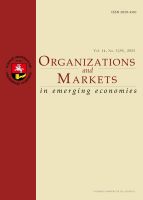Hybridizing Technology Management and Knowledge Management to Spur Innovation: A System Dynamics Approach
Hybridizing Technology Management and Knowledge Management to Spur Innovation: A System Dynamics Approach
Author(s): Suryanarayana Reddy, Muddangala Naresh Babu, Gundraju Yamuna, Thaya Madhavi, Cristina Claudia Bizon, Nicu Bizon, Phatiphat ThounthongSubject(s): Business Economy / Management, Management and complex organizations, Financial Markets, ICT Information and Communications Technologies
Published by: Vilniaus Universiteto Leidykla
Keywords: innovation; furniture manufacture; knowledge management; technology management; modeling and simulation; information conversion;
Summary/Abstract: The purpose of this research is to identify the drivers of innovativeness in a furniture manufacturing company. The scenario is the business environment where the hybridization of Technology Management (TM) and Knowledge Management (KM) is operative to promote innovation. The elements of the Technology Acceptance Model (TAM) and Socialization-Externalization-InternalizationExternalization (SECI) Model of KM have been modeled and used for simulation for the identification of the role played by the factors influencing the furniture design information conversion rate. The research follows the case study method to research as it draws data from a single company. Data from a multinational furniture manufacturing company that has over 10,000 products and operates in 24 countries have been used for simulation purposes. Results have shown that among the five factors that influence information conversion rate, the company should focus on correction efficiency and calculation efficiency enhancement if the aim is to maximize product and process innovations; and enhance contextualization efficiency if the priority is immediate results of innovativeness improvement. The results have also shown that about 615 innovative products and processes can be produced in six months by improving the correction efficiency to 80%. The theoretical implication of the study is in the form of a model which can be used by innovative companies to identify the critical factors that influence innovativeness, and the practical implications are in the form of suggestions to the managers of the furniture manufacturing company to enhance their innovativeness so as to gain competitive advantage in business.
Journal: Organizations and Markets in Emerging Economies
- Issue Year: 14/2023
- Issue No: 3
- Page Range: 696-720
- Page Count: 25
- Language: English

